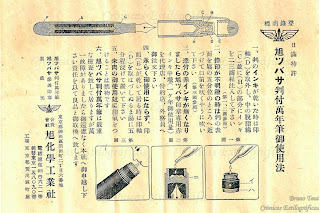
This Asahi Tsubasa Hantsuki Mannenhitsu (旭ッバサ判付萬年筆), such seems to be the model name, is a truly interesting pen and it shows several unusual features.
 The pen, uncapped, with the shut-off valve and the main thread between section and barrel half open.
The pen, uncapped, with the shut-off valve and the main thread between section and barrel half open. It is a grey celluloid eyedropper with a shut off valve, as is the case of most Japanese eyedroppers. The package included a traditional eyedropper, though its rubber bulb is no longer usable, and a small bottle of solid ink to be dissolved in water and ink the pen in the absence of an inkwell.
The cap looks longer than usual, and it is easy to see that the nib and the section barely occupy two thirds of the space within. The black ring on the cap, apparently an old sticker, is indeed a thread for a shorter cap that hides the stone to carve the seal (hanko, 判子), as was the case on the old Japanese Swan pen I showed some time ago. However, this pen shows some differences—under the seal there is a small deposit for ink that, going through the porous stone, allows printing the seal without the need of an inkpad.
 The top of the cap, disassembled. The brown flat piece is the uncarved stone for the seal. It is attached onto a black piece with a thread fitting on the cap, on the far end of the pic, creating a small deposit for the ink. It would go through the porous stone when printing the seal.
The top of the cap, disassembled. The brown flat piece is the uncarved stone for the seal. It is attached onto a black piece with a thread fitting on the cap, on the far end of the pic, creating a small deposit for the ink. It would go through the porous stone when printing the seal. Then, the name of the model makes perfect sense: hantsuki (判付) means that this pen is also a seal. And in the instruction sheet it can be read that this pen combines three tools in one—the pen, the seal, and the inkpad!
The nib is a size 3 made of steel, and is slightly flexible despite its shape, curved downwards, like a posting nib. It is engraved with the company logo and some Japanese characters, some of which read Asahi Tsubasa, and a more descriptive “IRIDIUM / PEN / -<3>-”.
The dimensions of this pen are as follows:
Diameter: 13.0 mm.
Length capped: 130 mm.
Length uncapped: 105 mm.
Length posted: 155 mm.
Dry weight: 15.8 g.
All these elements show this was a pen from the war period, which in Asia was a lot longer than in the West. Probably, this pen dates back from the 1930s. The company was based in Arakawa, Tokyo.


















No comments:
Post a Comment
Your comments are welcome and appreciated.